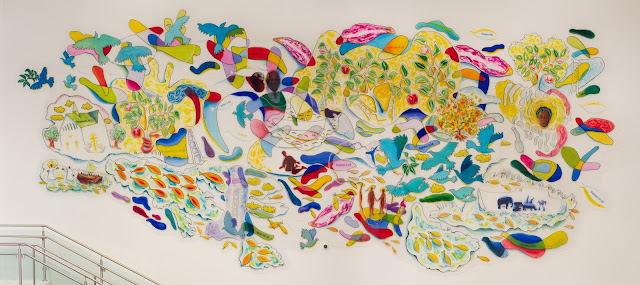FOR IMMEDIATE RELEASE
Media contact:
Davinia Reed
713.526.1015
Abstract Art Installation By Artist Floyd Newsum Helps Define Houston Megachurch
Rarely does the Houston Museum of African American Culture (HMAAC) get the opportunity to work with an artist to express his faith with art and help a church define its mission. But that’s exactly what has happened with the installation of a major new artwork by nationally renowned artist Floyd Newsum, that dominates a main wall in Wheeler Avenue Baptist Church’s (WABC) Cathedral Atrium.
After a conversation with Wheeler Senior Pastor Marcus Cosby, Newsum, a church member with a history of solo and group exhibitions at HMAAC, and whose work hangs in the National Museum of African American History and Culture in Washington DC, approached the museum to discuss the concept, which HMAAC CEO John Guess, Jr. enthusiastically endorsed.
The 38 by 16 feet acrylic relief installation is titled Grace and Mercy, underscoring two of the major narratives the church stands for. Newsum has described the work as “cathedral beautification, with historical references to the evolution of Wheeler as well as the church’s old and New Testament scriptural foundation.” What stands out about Grace and Mercy is its abstraction, the favored medium of Newsum.
Art has always had a place in churches. But many churches have seemed to be out of touch with contemporary art, failing to regard engagement with abstract art as a significant spiritual practice. That seems to have changed recently, with a growing number of abstract expressionists, like Newsum, being welcomed into sanctuaries. For example, artist Jacques Jarrige earlier this year installed a 10-foot tall sculpture of Christ made of hammered aluminum 90 feet in the air in the center of the St. John the Divine Cathedral’s nave in New York City. And Gabriele Wilpers’ modern abstract glass sculpture on the West Wall of the Church of the Transfiguration in Orleans, Massachusetts, portraying Christ’s Transfiguration, has been viewed by church congregants and others for over a decade.
According to Guess, who began talking with Newsum months ago, “I just thought this possibility of abstraction entering a megachurch could open so many doors for worshippers to understand the many layers of faith through work, that like faith, is experienced by the readily seen and simultaneously understood at deeper levels by what is unseen but that exists.“
Newsum has previously described his work as “thought-provoking, with personal iconography and colorful contrasting forms” that present viewers “with spiritual and philosophical challenges, invoking a wide range of emotions.” For him, symbolic interpretation has meaning given the fluid contexts of our lives; lives best understood as the moving forward of our singular journeys that ultimately transition but never end.
That is certainly true of Grace and Mercy. Projecting strong and vibrant colors with lots of energy, Newsum fuses symbols like the bird, fish, and ladder that have personal meaning to him with religious references to Noah’s Ark, Adam and Eve, Prayer and Wheeler’s beginnings as a white, wooden framed, large shotgun styled place of worship.
“I am reminded of Matthew Ritchie’s similar installation at the Kemper Art Museum in Kansas City,” said Guess. “I look for Floyd’s piece to be the same kind of attraction for Wheeler.”
For Newsum, because it is for his church, this installation has been one of his most emotional creations. “What makes this installation so meaningful,” he says, ‘is that it hangs in my place of worship. I get to permanently share my gratitude with my fellow church members.”
Floyd Newsum’s abstract installation and WABC’s embrace of it is one of those rarely seen experiences at religious institutions, but hopefully it will serve as an example for other churches and artists.
.
ABOUT FLOYD NEWSUM
Floyd Newsum, a painter and printmaker for over four decades, has been in over 80 solo and group exhibitions, with his work displayed at the Taft Museum in Cincinnati; Contemporary Arts Center, New Orleans; Studio Museum in Harlem, New York; Houston Museum of African American Culture; Contemporary Arts Museum, Houston; Museum of Fine Arts Houston; Philadelphia Museum of Arts; Polk Museum, Lakeland Florida; and the David C. Driskell Center, University of Maryland College Park.
His works are in the permanent collections of the Smithsonian National Museum of African History and Culture, Washington DC; Studio Museum in Harlem, New York; Philadelphia Museum of Arts; Museum of Fine Arts Houston; Art Museum at Arizona State University in Tempe, Arizona; David C. Driskell Center, University of Maryland College Park; Art Museum of South Texas; and other museums and institutions. His works have been published in catalogs, books and magazines. Although known for his paintings on paper, he has created prints, drawing and sculptures, the latter the medium for four of his six public art commissions.
Floyd Newsum is a Houstonian by way of Memphis. Currently a University of Houston-Downtown Art Professor, he received a Bachelor of Fine Arts at the Memphis Academy of Arts and a Master of Fine Arts from the Tyler School of Art, Temple University.
ABOUT THE HOUSTON MUSEUM OF AFRICAN AMERICAN CULTURE

No comments:
Post a Comment